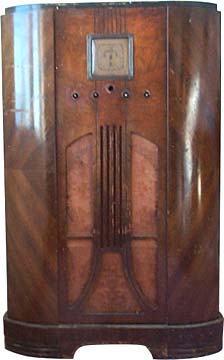 Canadian
General Electric A-87
Canadian
General Electric A-87 Canadian
General Electric A-87
Canadian
General Electric A-87
ca. 1935-36, s/n 310

This is one of my first two consoles that I ever got. It came from a collector in Dorchester, New Brunswick, who decided that he needed a bit more room in his house. It didn't have any knobs on it, and I haven't a clue yet what they should look like. It was missing a 6F6 tube, so I'll have to borrow one from the other console that I got, before I fire it up.
There was only one little chip of veneer broken off, on the base at the right, about 5 cm by 2 cm. The rest of it has a few shallow scrapes and some worn spots on top.
Technical Data Line Volts / Freq. 105-125V / 60 Hz Watts 60 Height 101 cm (39.75") Width (not incl. base) 63.5 cm (25") Depth 35.5 cm (14") Band A - Standard Broadcast 540 kHz - 1,800 kHz Band B - Shortwave 1.8 MHz - 6.0 MHz Band C - Shortwave 6.0 MHz - 18.0 MHz IF frequency 460 kHz
Rectifier 5Z3 RF Amplifier 6K7 1st Detector 6L7 Oscillator 6J7 I.F. 6K7 2nd Detector and AVC 6H6 Audio 6F5 Output 6F6 Ther is an American model with the same number (General Electric A-87) but it is quite different from this one. This one uses the same data sheet in the RCC manual as for the Victor C8-15.
The dial face turned out to be in excellent condition, behind the dusty plastic cover. It'll look real nice backlit by the two pilot lamps.
I'll see if that reddish brown mark will come off with water and a cotton-tipped applicator. I don't want to go near the graphics.
I was mystified by this tuning mechanism at first, then after I stuck a Phillips screwdriver into it, I figured out that it works like speed-reduction gears. Now I have to see if a bit of 1/4 inch rod will serve for a tuning knob shaft. I haven't figured out what the three copper-coloured thingies around it do, nor does the toothed gear seem to drive anything else.
The band selector switch on the right is linked to the small pointer at the bottom of the dial face.
This just in: The tuning knob is supposed to work such that if you push it it, the dial turns quickly, If you leave it in the normal position (out) it turns slowly.
More info and photos later.
Back to Vintage Radio Home